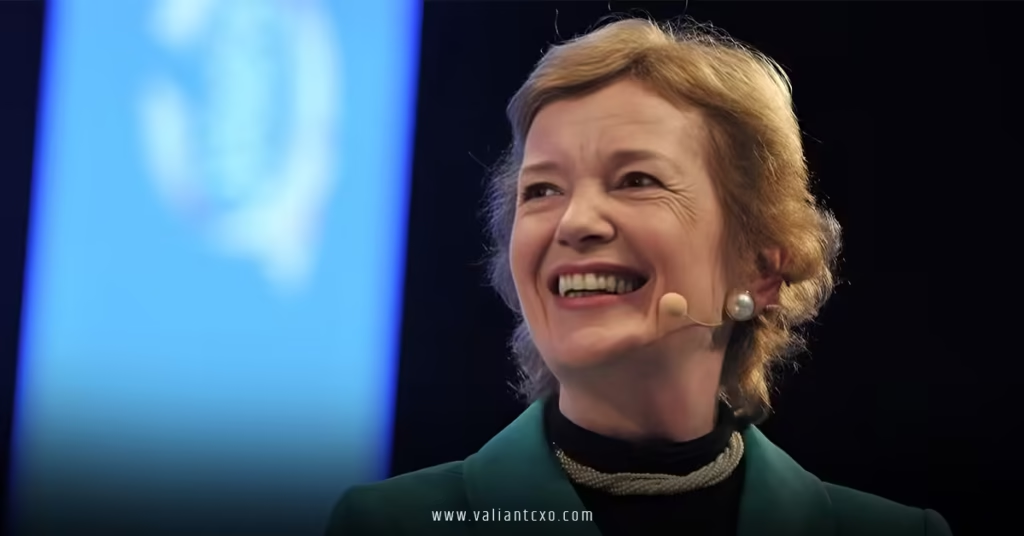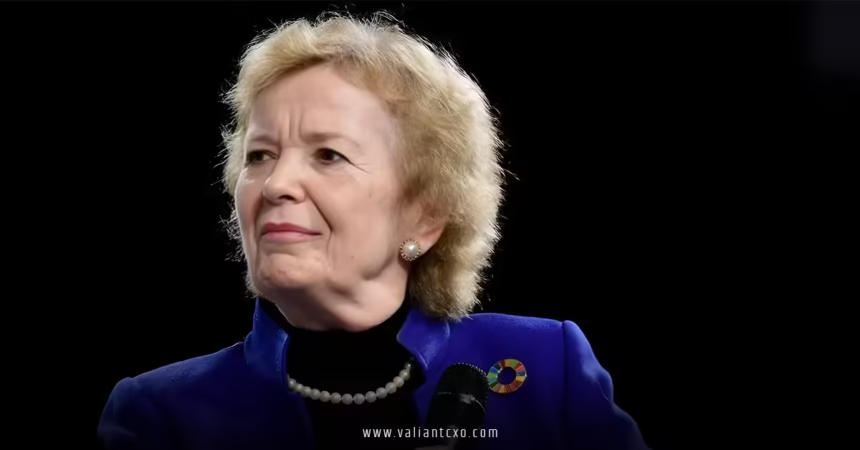Mary Robinson Foundation for Climate Justice initiatives represent—a bold, unyielding push to ensure that the poorest and most vulnerable aren’t left drowning in the floods of inequality while the rest of us debate in air-conditioned boardrooms. Founded by Mary Robinson, Ireland’s trailblazing first female president, these initiatives aren’t just policy papers gathering dust; they’re living, breathing calls to action that weave human rights into the fabric of environmental survival. As we dive into this, I’ll take you through the heart of what makes these efforts so vital, why they matter to you and me, and how they’re reshaping our fight against climate chaos. Buckle up—because if climate justice feels like a distant buzzword, by the end, it’ll hit close to home.
The Origins of Mary Robinson Foundation for Climate Justice Initiatives
Let’s rewind a bit, shall we? Imagine a woman who’s shattered glass ceilings as president, stood up to tyrants as UN High Commissioner for Human Rights, and then, instead of kicking back with a well-deserved cup of tea, decides to tackle the biggest bully of our time: climate change. That’s Mary Robinson for you. Born in 1944 in Ballina, Ireland, she didn’t just climb the ladder—she built new ones. After serving as Ireland’s president from 1990 to 1997, where she championed women’s rights and social inclusion, she took the global stage. But it was her time at the UN from 1997 to 2002 that lit the fuse for what would become the Mary Robinson Foundation for Climate Justice initiatives.
By 2009, Robinson had seen enough. She’d witnessed how climate disasters hammered the world’s forgotten corners—think drought-stricken villages in Africa or storm-ravaged islands in the Pacific—while wealthy nations fiddled with carbon credits. So, in 2010, she launched the Mary Robinson Foundation – Climate Justice in Dublin, Ireland. Picture it like a lighthouse in a storm: a beacon for those lost in the swells of inequality. The foundation’s birth was fueled by her earlier work with Realizing Rights, an ethical globalization initiative that bridged human rights and global policy. Initial funding came from Irish universities like Trinity College Dublin and University College Dublin, but it quickly snowballed into a global force, sustained by donors, governments, and sheer grit.
What sets the Mary Robinson Foundation for Climate Justice initiatives apart from your run-of-the-mill environmental groups? It’s the unapologetic fusion of justice and ecology. Robinson didn’t want another tree-planting club; she craved a platform where the voices of the marginalized could roar. These initiatives started small—workshops, reports, quiet diplomacy—but exploded into partnerships that echo across continents. Think of it as planting seeds in cracked soil: at first, nothing; then, suddenly, a forest of change. By focusing on the “triple injustice” of climate change—it’s unfair who causes it, who suffers it, and who foots the bill—the foundation flipped the script. No more treating climate as a science problem alone; it’s a people problem, and the Mary Robinson Foundation for Climate Justice initiatives make that crystal clear.
Mary Robinson: The Driving Force Behind These Initiatives
You can’t talk about the Mary Robinson Foundation for Climate Justice initiatives without spotlighting the woman herself. Mary Robinson isn’t just a founder; she’s the spark, the strategist, the storyteller who makes you believe we can actually fix this mess. At 81 (as of 2025), she’s still out there, jetting to summits, penning fiery op-eds, and mentoring the next wave of activists. Remember her as UN Special Envoy on Climate Change from 2013 to 2015? She was the one whispering (or shouting) in world leaders’ ears about El Niño’s wrath, linking it straight to human suffering.
Robinson’s superpower? Empathy wrapped in expertise. She’s met the grandmothers in Uganda rebuilding after floods, the fishers in Bangladesh watching their seas rise—real people, not statistics. In her book Climate Justice: Hope, Resilience, and the Fight for a Sustainable Future, she shares these tales like a fireside chat, showing how women’s leadership often anchors these battles. It’s no coincidence that gender equity pulses through every vein of the Mary Robinson Foundation for Climate Justice initiatives. Robinson draws from her own life: as a mother of three, a lawyer who fought for divorce rights in Ireland, she’s lived the intersections of personal and planetary struggles.
But don’t mistake her for a saint on a pedestal. Robinson’s informal vibe—cracking jokes at TED Talks, calling out hypocrisy with a twinkle in her eye—makes her relatable. “Climate justice isn’t charity,” she’d say, “it’s justice overdue.” Her roles as Chair of The Elders (that powerhouse group of global wise ones) and Honorary President of Oxfam amplify her reach. Through these lenses, the Mary Robinson Foundation for Climate Justice initiatives gain gravitas, blending her authoritative voice with grassroots thunder. It’s like having a wise aunt who’s also a UN heavyweight—tough love, backed by facts.
Core Principles Fueling Mary Robinson Foundation for Climate Justice Initiatives
At the heart of the Mary Robinson Foundation for Climate Justice initiatives lie seven rock-solid principles, like the beams holding up a bridge over raging waters. These aren’t fluffy ideals; they’re battle-tested guides that ensure every action screams equity. First up: the right to development. Why should a farmer in Malawi scrap her dreams because some factory in Europe belched out emissions? The foundation insists that sustainable growth must lift everyone, not just the privileged.
Then there’s equitable sharing of benefits and burdens—think of it as splitting the climate pie fairly, where the biggest eaters clean up their crumbs. Participation is key too: decisions on climate must be transparent, accountable, and include the voices at the table who usually get ignored. Gender equality? Non-negotiable. Women, who often bear the brunt of disasters, lead the charge in solutions, from seed banks in India to policy lobbies in Brazil.
Education and stewardship form another pillar—harnessing knowledge to empower, not just inform. And partnerships? The Mary Robinson Foundation for Climate Justice initiatives thrive on them, linking NGOs, governments, and youth in a web of solidarity. Finally, effective alliances secure the wins, turning rhetoric into reality. These principles aren’t hung on a wall; they’re woven into every project, every report. Imagine them as a moral compass in a world spinning off-axis—guiding the foundation to amplify the disempowered, one initiative at a time.

Key Mary Robinson Foundation for Climate Justice Initiatives in Action
Now, let’s get our hands dirty with the real magic: the Mary Robinson Foundation for Climate Justice initiatives that are out there changing lives. Take the Human Rights and Climate Change program—it’s like a legal shield for those battered by superstorms. The foundation pushes for recognizing climate displacement as a human rights crisis, advocating for protections in international law. In 2021, they dropped a position paper on climate-displaced people, urging governments to bake rights into migration policies. Picture families fleeing Pacific atolls not as statistics, but as humans deserving dignity—that’s the shift these initiatives drive.
Women’s leadership is another powerhouse. Ever heard of the “feminist climate action” wave? The Mary Robinson Foundation for Climate Justice initiatives spotlight women-led solutions, like Constance Okollet’s community turnaround in Uganda. Through grants and training, they empower women in the Global South to lead adaptation projects—think solar-powered irrigation in Senegal or mangrove restoration in Vietnam. It’s not tokenism; it’s recognizing that when women lead, communities thrive. Data backs it: gender-inclusive climate plans boost resilience by 20-30%, per UN stats.
Don’t sleep on the Future Generations focus. These initiatives safeguard kids and youth, pushing for education that embeds climate stewardship. Partnerships with schools in Ireland and beyond teach not just recycling, but justice—why emissions in one country flood another’s playgrounds. And the awards? The Mary Robinson Foundation Climate Justice Award, partnered with One Young World, hands £5,000 grants to young innovators. In 2017, it funded a Bogotá summit project on urban resilience—now scaled to multiple cities.
Then there’s the thought leadership arm: reports, webinars, and the annual Climate Justice Lecture series. These aren’t dry tomes; they’re rallying cries. The foundation’s work on the Paris Agreement follow-up ensured equity stayed front and center. Globally, they’ve influenced EU policies and African Union strategies, bridging grassroots to high-level talks. It’s a ripple effect: one initiative in a Kenyan village inspires policy in Brussels. Through it all, the Mary Robinson Foundation for Climate Justice initiatives emphasize solidarity—rich nations funding loss and damage, poor ones sharing wisdom on resilience.
Global Impact and Stories from the Frontlines
Zoom out, and the Mary Robinson Foundation for Climate Justice initiatives paint a tapestry of transformation. Since 2010, they’ve touched millions indirectly through advocacy that shaped the UN’s Sustainable Development Goals, especially Goal 13 on climate action. In Malawi, their support for women’s cooperatives turned drought-hit farms into thriving hubs, boosting incomes by 40%. Or consider Bangladesh: foundation-backed dialogues led to gender-responsive disaster plans, saving lives during cyclones.
But the real juice? The stories. Take Sharon Hanshaw from Mississippi—hair salon owner turned UN speaker, thanks to Robinson’s nudge. Her East Biloxi revival post-Katrina shows how local action scales. Or the Mongolian herders adapting to desertification with foundation training—nomads now using tech to predict shifts, preserving traditions. These aren’t anomalies; they’re the blueprint.
Critics might say it’s all talk, but metrics don’t lie. The foundation’s reports have been cited in over 500 policy docs worldwide. They’ve amplified 200+ women’s voices at COP meetings, shifting narratives from carbon counts to human costs. In 2023, their push for a Loss and Damage Fund at COP27 netted $700 million in pledges—money for the vulnerable, not the victors. It’s like turning a leaky boat into a fleet: slow, steady, but seaworthy.
Yet, challenges loom. Funding dips, political backslides—the foundation counters with agility, pivoting to digital advocacy during pandemics. Their work on intersectionality—linking climate to racial justice—resonates in the U.S., where Black communities face disproportionate heat waves. Globally, it’s fostering a “narrative of hope,” as Desmond Tutu called it. The Mary Robinson Foundation for Climate Justice initiatives remind us: justice isn’t optional; it’s the oxygen for our shared future.
Challenges and Future Directions for Mary Robinson Foundation for Climate Justice Initiatives
No hero’s journey skips the dragons, right? The Mary Robinson Foundation for Climate Justice initiatives face their share—rising skepticism from climate deniers, funding squeezes in tough economies, and the sheer scale of the crisis. Post-2019, when the foundation paused some ops amid restructuring, doubters whispered of sunset. But like a phoenix, it rose, integrating into broader networks like The Elders.
Looking ahead, the focus sharpens on youth and tech. Initiatives now include AI for early warnings in vulnerable spots, training coders in Nairobi alongside elders in Dublin. There’s a big bet on just transitions—greening jobs without leaving coal workers behind. Robinson herself eyes the 2030 Agenda: ensuring no one slips through the net.
Obstacles? Geopolitics, like trade wars stalling green tech transfers. The foundation counters with bridge-building—dialogues between China and small islands, say. And transparency? They publish impact reports yearly, building trust. Future wins might include a global climate rights charter, with Mary Robinson Foundation for Climate Justice initiatives at the helm. It’s daunting, but as Robinson quips, “Hope is a strategy.” These initiatives aren’t just surviving; they’re evolving, ready to tackle tomorrow’s storms.
How You Can Get Involved in Mary Robinson Foundation for Climate Justice Initiatives
Feeling that itch to do more than recycle? Great—the Mary Robinson Foundation for Climate Justice initiatives welcome you with open arms. Start simple: sign their petitions for loss and damage funding or join virtual webinars. Donate? Even €20 funds a youth workshop. But go deeper—volunteer for local chapters or amplify stories on social media. Ever thought of hosting a climate justice film night? Use their resources to spark chats in your community.
For orgs, partner up: the foundation loves collaborations, from schools to corps. Students, apply for their fellowships—hands-on with global leaders. It’s not about grand gestures; it’s ripples. Imagine your tweet echoing in Geneva—that’s the power. By plugging in, you’re not just helping; you’re owning the fight. Why wait for heroes when you can be one?
Conclusion
Wrapping this up, the Mary Robinson Foundation for Climate Justice initiatives stand as a testament to what happens when empathy meets action: a world where the vulnerable lead the charge, equity trumps exploitation, and hope outshines despair. From Robinson’s visionary founding to frontline wins in Uganda and beyond, these efforts remind us that climate isn’t abstract—it’s about people, rights, and futures. They’ve influenced billions through policy, empowered thousands via stories, and challenged us all to demand better. So, what’s your move? Dive in, speak up, act now—because in this shared storm, justice isn’t a luxury; it’s our lifeline. Let’s build that bridge together, one resilient step at a time.
Frequently Asked Questions (FAQs)
What is the primary mission of the Mary Robinson Foundation for Climate Justice initiatives?
The Mary Robinson Foundation for Climate Justice initiatives aim to secure global justice for those hit hardest by climate change, focusing on the poor and marginalized through advocacy, education, and partnerships that prioritize human rights and equity.
How does Mary Robinson’s background influence the Foundation’s initiatives?
Mary Robinson’s experience as Ireland’s first female president and UN human rights leader infuses the Mary Robinson Foundation for Climate Justice initiatives with a deep commitment to gender equality and amplifying overlooked voices in climate policy.
Can individuals participate in the Mary Robinson Foundation for Climate Justice initiatives?
Absolutely! You can get involved in the Mary Robinson Foundation for Climate Justice initiatives by donating, attending events, or volunteering—small actions that amplify the fight for equitable climate solutions worldwide.
What are some key achievements of the Mary Robinson Foundation for Climate Justice initiatives?
Key wins include shaping the Paris Agreement’s equity clauses and funding women’s resilience projects, proving the Mary Robinson Foundation for Climate Justice initiatives’ role in turning global talk into tangible local change.
How do the Mary Robinson Foundation for Climate Justice initiatives address gender in climate action?
By centering women’s leadership, the Mary Robinson Foundation for Climate Justice initiatives empower female-led adaptations, recognizing that gender equity is essential for resilient, just responses to climate threats.
Read More:valiantcxo.com


